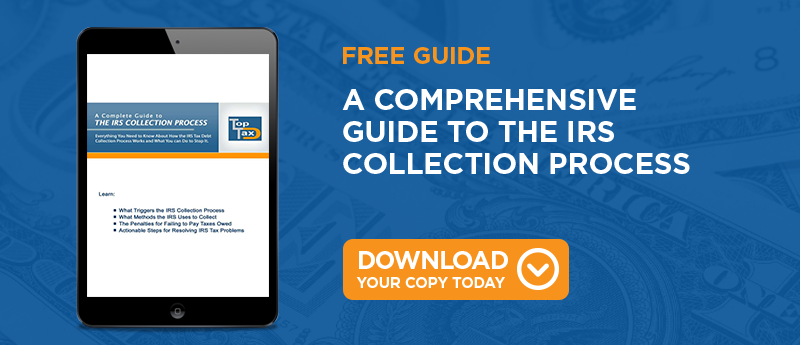
The IRS utilizes a number of collection activities to recoup debts that taxpayers owe to it. Among them, tax levies are many times the most difficult with which to cope.
When the IRS levies someone’s property, it assumes financial ownership of the asset until the tax debt is paid in full. However, you could have an IRS tax levy released with any of these 10 effective tactics.
1. Pay the Tax Debt in Full
The most effective way to get a tax levy released is to pay what you owe to the IRS in full. If you have the financial means, you should pay the obligation in full, and make sure your account with the IRS has a zero balance.
However, paying off a tax debt in full can be difficult to do when you owe hundreds or thousands of dollars. Rather than risk a levy on any of your assets like your bank account, house, or vehicle, you may want to use other methods to get the levy released quickly.
2. Appeal the Levy
You have 30 days from the time the IRS notifies you of its intent to levy an asset to make a formal appeal. The appeal temporarily stops the levy from being enacted until a decision is made on your tax situation.
To file a formal appeal, you must complete and submit the IRS form 9423. Appealing a levy can be a relatively straightforward process. However, it is no guarantee that the IRS will reverse its decision to levy your assets.
Still, if you can prove the levy would create extreme financial difficulties for you, you should go ahead and file an appeal. The appeal could also uncover irregularities in the tax debt collection process that would compel the IRS to reverse its intent to levy your assets.
3. Request an Installment Agreement
When the IRS levies your assets, it will not relinquish its claim until the tax debt is satisfied. Rather than wait for months or years before this happens, you could have the levy released quickly by requesting an installment agreement with which to pay off your debt.
An installment agreement lets you make regular monthly payments on the obligation. The payments are based on how much money you make, which ensures they are affordable and practical. The agreement also releases the levy on your property.
4. Make an Offer in Compromise
When you cannot realistically pay off your full tax debt, you may be able to settle it with an Offer in Compromise. An OIC lets you resolve your debt for less than what you really owe. The IRS forgives the remaining portion of the debt if it accepts your OIC.
Your offer must be realistic and reflect the value of your current income and assets, however. Once your OIC is accepted, you have a limited opportunity to pay this lower amount and bring your IRS account to a zero balance. The levy against your property will then be released.
5. Apply for the Fresh Start Program
The IRS offers the Fresh Start Program for people with tax debts of $25,000 or less. To qualify for this program, you must:
- Owe $25,000 or less in back taxes
- Agree to have payments automatically deducted from your bank account
- Have made three consecutive installment agreement payments and not be in default
- Be in compliance with all of your tax return filings
- Be current on all of your estimated tax payments
Once you are accepted into the Fresh Start Program, the IRS will file the Form 109169(c) with your local county office. To apply for this program, you must fill out and submit IRS form 12277. You also should notify all three credit bureaus about your participation in the program after your application is approved.
6. Wait Out the Statute of Limitations
The IRS has 10 years in which to collect on a debt you owe. If it is nearing the end of that 10 years, you may simply wait for the statute of limitations to expire.
Once the 10 years is up, your debt is automatically absolved. You do not have to make any payments on the debt after that time limit is up.
7. Make a Case for Financial Hardship
When an IRS tax levy would create severe monetary difficulties for you and your household, you can make a case for financial hardship with the IRS. The IRS must leave you with enough money with which to pay your immediate household expenses.
If you can prove that you would not be able to do so with a levy in place, you could make a claim of financial hardship and have the IRS release its levy. Making the claim may require you to provide financial documents like bank statements and pay stubs.
8. Prove Your Assets Have No Equity
The primary reason that the IRS uses levies is to liquidate the property if necessary to recoup some or all of the money people owe to it. When your assets have no monetary value, however, you could prove to the IRS that they are not worth selling.
If you can establish that your assets have no equity, you may be able to get the levy against them released. Making this case might require you to provide bank statements showing the balances in checking, savings, or retirement accounts. You also may need to provide appraisal statements for the assets showing they are not worth anything.
9. Ask for a Partial Payment Agreement
If you cannot pay off what you owe even with an installment agreement, you could settle the debt in a more affordable manner by asking for a partial payment agreement. A partial payment agreement is reserved for taxpayers who would experience physical or financial challenges with a regular installment agreement. The partial agreement would let you make reduced payments on your tax debt each month, thereby allowing you to avoid financial strain while satisfying what you owe to the IRS.
10. File for Bankruptcy
As a last resort, you could file for bankruptcy to get the tax levy against your property released. Bankruptcy takes a negative toll on your credit report for several years after you file. However, during the time your case is being filed and adjudicated, no creditor even the IRS can contact you about your debts or take any collection actions against you.
Depending on the age and amount of your tax debt, you could have it consolidated into a Chapter 13 bankruptcy wherein you pay off your debts progressively each month. In rare cases, you could have the tax debt forgiven with a Chapter 7 bankruptcy.
These 10 methods are available to you when you want to have a tax levy against your property released. They are designed to help you avoid having your assets sold off in order to settle your IRS debt. They also can make paying off your tax debt easier and more affordable in some instances.



